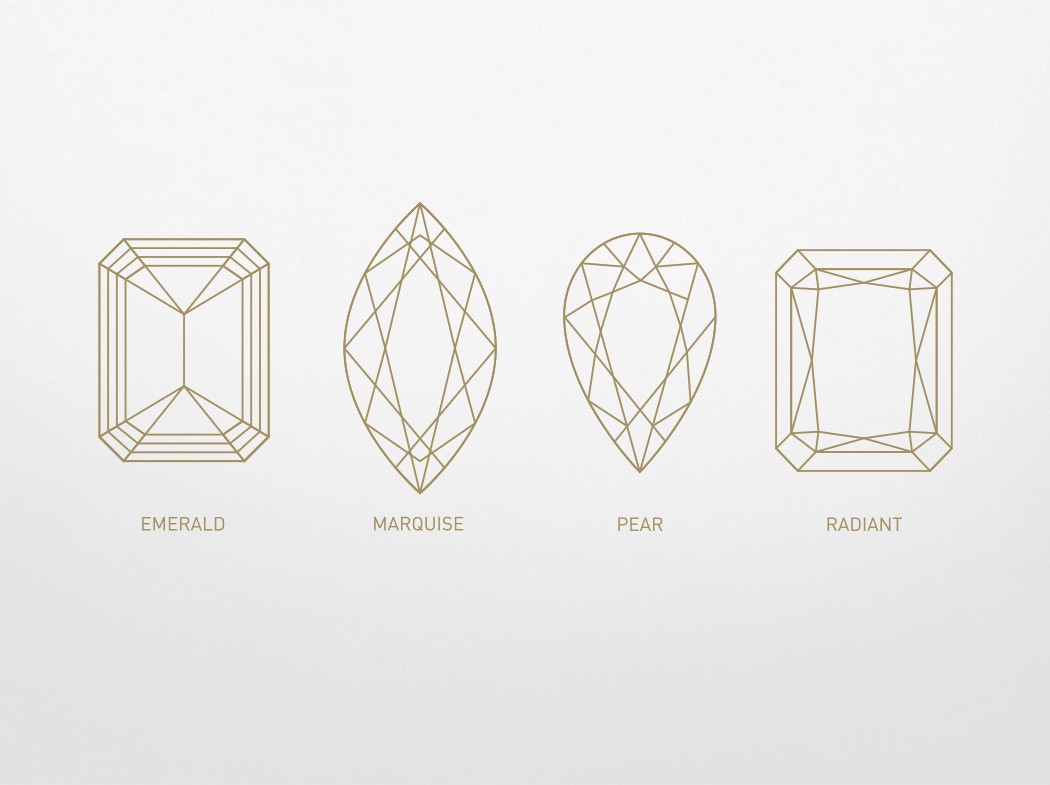The cut of any gemstone is determined firstly by its shape but also the skill to which the stone has been physically cut and the stones proportions. Throughout this feature we will explore three of the most popular fancy cuts, their properties and overall style.
The Marquise Cut
The marquise cut is an elegant and sophisticated stone cut which, today, is an exceptionally popular choice for engagement or dress rings. This particular cut originated in the 1740s when King Louis XV instructed his jewellery designer to form a diamond that mirrored the lips of his mistress, Marchioness Madame de Pompadour.
The marquise cut has a second link to French history, often referred to as the ‘Navette’ which translates as ‘little ship’. This reference is supposed to be due to the stones shape, or cut, resembling the pointed ends of a ship’s hull.
This fancy cut is used across a number of different gemstones, most commonly diamonds, emeralds, rubies and sapphires. Traditionally, a marquise cut stone is set vertically, pointing north and south, as shown here. It is possible to set a marquise cut gemstone horizontally, this is however seen more often as part of a dress ring or as accent side stones to complement a centrepiece. Catherine Zeta Jones famously received a stunning, horizontally set marquise, engagement ring from Michael Douglas in 1999. This style of setting can also be referred to as an ‘east to west’ diamond, pictured here.
The marquise covers a larger surface area than many other gemstone cuts of the same carat weight because of its elongated shape. The central oval meets an elegant point at each end and is the perfect engagement ring choice for an individual who wants to create the illusion of an elongated finger. David Beckham, world renowned footballer, proposed to Victoria Beckham in 1998 with a 3.00ct marquise cut engagement ring set in yellow gold, much like the example shown here. Since then, Victoria’s collection of engagement rings has grown to fourteen.
The Pear Cut
The pear is a diamond cut combining both the round brilliant and marquise cuts to create a unique and distinctive shape, shown here in platinum. Similarly to the marquise, the pointed end of this cut is a complimentary shape to all hands, giving the finger a slender and elegant look.
The pear shape was first created in the 1400s by Lodewyk Van Bercken, a Flemish cutter from Bruges who originally invented the scaif. Bercken polished the facets of a diamond in order to optimise the refractions of light through the stone, creating the fire and brilliance you see throughout jewellery today.
The pear cut diamond holds approximately 58 facets, with the most popular pear cuts often having a length to width ratio of approximately 1.50 to 1.70. It is important to note that the ideal length to width ratio is subjective and often dependent on the particular piece of jewellery. A pear cut diamond solitaire, for example, is often preferred with a greater width whereas a pair of pear cut diamond earrings will often feature a greater length.
Like many fancy cuts, the pear cut is a popular choice with celebrities across the world. The elegant shape combined with, or without, a diamond halo or shoulders, is known for being seen on the likes of Princess Charlene of Monaco, Victoria Beckham, Anna Kournikova and Katherine Heigl.
Throughout our dedicated jewellery pages, you will find a vast selection of pear cut diamonds. These cuts are included not only in our engagement ring collections but also across pages such as necklaces & pendants, earrings and dress rings. Here, you will often see the pear cut combined with other diamond cuts or coloured stones, including, round brilliant, marquise and many more.
Emerald
The emerald cut is a rectangular shape with truncated corners to make it look octagonal. The cut has a large surface table, therefore providing excellent visibility throughout the stone. It is because of this that it is often advised to choose an emerald cut stone with a high clarity. Emerald cuts are of course available in a selection of clarities, as explored throughout Our Guide To Diamonds, but the majority are selected at SI1 and above.
If you are considering an emerald cut for a piece of jewellery or an engagement ring there are two varieties of cuts that can appear with this rectangular shape, step cut emerald and a radiant cut, which you may wish to consider.
• A step cut stone contains facets which are arranged in a parallel fashion appearing like steps. This gives the illusion of the stone appearing larger than in another shape, such as a round brilliant cut.
• A radiant cut stone provides striking fire and offers the wearer a brilliance similar to that of a round brilliant cut stone. The shape is often square or rectangular but features truncated or cropped corners.
Although the inner detail of the emerald step cut and radiant cut differ, the shape of the emerald gemstone itself remains the same, exquisite and extraordinary.
The definitive origin of the emerald cut is unknown however, because of the table style and multitude of facets, it could be dated back to the Art-Deco era. Today, the emerald cut remains a classic cut and a key feature throughout our masterpiece collection.
If you would like further information on fancy cut diamonds or the process of cutting diamonds, our features page also includes a variety of articles, such as ‘Making The Cut: Exploring Diamonds’ or please contact us here.

